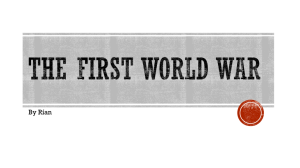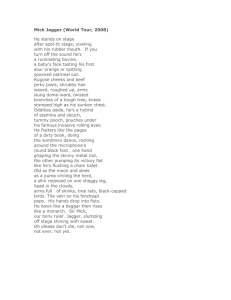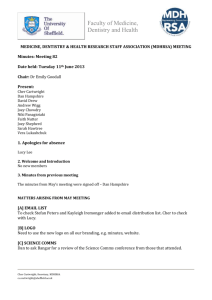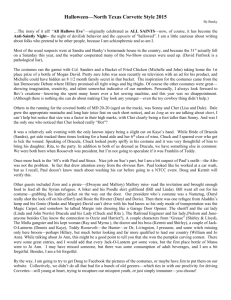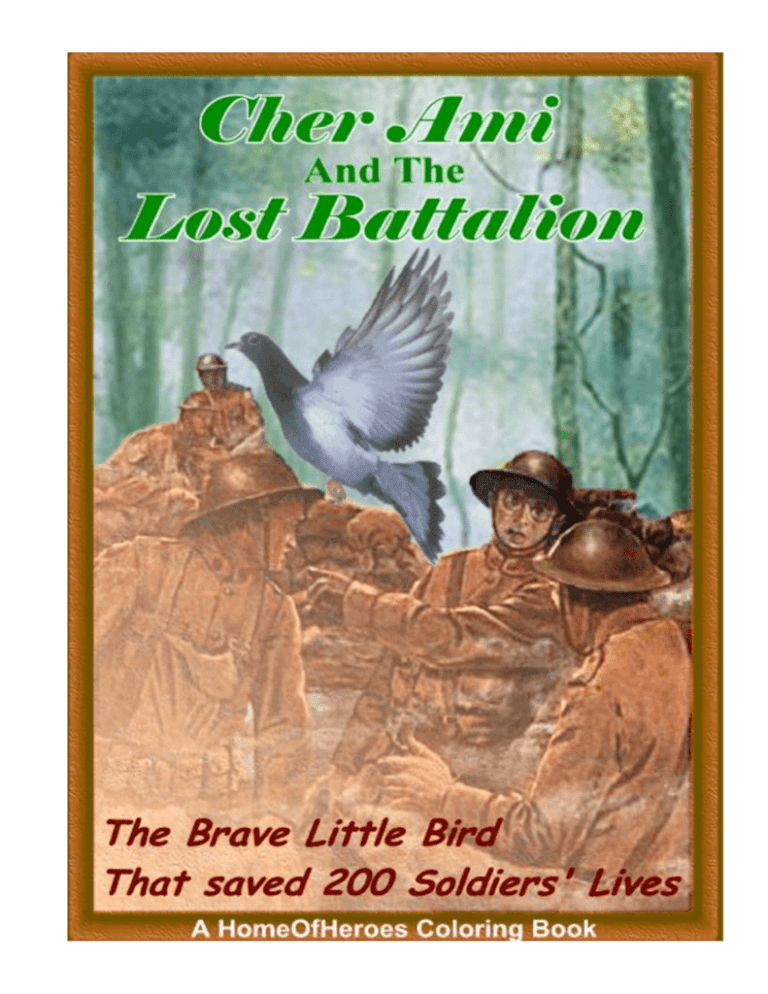
And
Of World War I
THE BRAVE LITTLE PIGEON THAT SAVED 200 LIVES!
BY DOUG & PAM STERNER
A Coloring Book for Kids * Based on a True Story
This is a Hall Of Heroes electronic book, and is available for free download and printing from www.HomeOfHeroes.com.
You may print and distribute this booklet in quantity for all non-profit, educational purposes.
HomeOfHeroes.com, Inc
P. O. Box 122
Pueblo, CO 81003
Copyright © 2001 By HomeOfHeroes.com, Inc.
ALL RIGHTS RESERVED
(Dear Friend)
The ability to communicate is essential to soldiers in the field. Without
communications to their commanders or support units in the rear area,
soldiers on the front line can't send messages about their progress, request
needed supplies, or call for help when things reach their worst.
During World War I, messages were sometimes transmitted by wire
(telegraph of field phone), but two-way radio communications had not yet
become available. Sometimes a unit was ordered to attack over a broad and
often difficult terrain, making it impossible to string the wire necessary for
communications. In these situations, a field commander often carried with
him several carrier pigeons.
Pigeons served many purposes during the war,
racing through the skies with airplanes, or even
being fitted with cameras to take pictures of enemy
positions. One of the most important roles they
served in was as messengers. An important message
could be written on a piece of paper, then that paper
neatly folded and secured in a small canister
attached to a pigeon's leg. Once the pigeon was
released, it would try to fly to its home back behind
the lines, where the message would be read and
transmitted to the proper military planners.
1
THE ARMY
IS DIVIDED AMONG SEVERAL DIFFERENT SPECIALTIES AND THE MEN
FROM EACH SPECIALTY ARE TRAINED FOR A PARTICULAR KIND OF WORK. INFANTRYMEN
ARE TRAINED TO FIGHT ON THE GROUND, ARTILLERYMEN ARE RESPONSIBLE FOR THE BIG
GUNS, ARMOR REFERS TO THE MEN WHO FIGHT IN TANKS, AND THE AIR SERVICE WAS THE
NAME FOR THE GROUP OF SOLDIERS WHO FLEW AIRPLANES WORLD WAR I. ONE OF THE
OLDEST OF THESE GROUPS OF SOLDIERS IS THE U.S. ARMY SIGNAL CORPS. THESE
MEN ARE THE ONES RESPONSIBLE FOR INSURING THAT MESSAGES BETWEEN ALL UNITS GET
THROUGH TO THE RIGHT PEOPLE. THE ARMY SIGNAL CORPS IDENTIFIES ITSELF BY A
TORCH WITH TWO CROSSED FLAGS. THESE REPRESENT SIGNAL FLAGS, A COMMON WAY
THAT MESSAGES WERE PASSED USING CODE.
WHEN
THE UNITED STATES ENTERED WORLD WAR I IN 1917, THE ARMY SIGNAL
CORPS WAS GIVEN 600 PIGEONS FOR THE PURPOSE OF PASSING MESSAGES WHEN SIGNAL
FLAGS OR A FIELD PHONE COULDN'T DO IT. THE PIGEONS WERE DONATED BY BIRD
BREEDERS IN GREAT BRITAIN, AND THEN WERE TRAINED BY AMERICAN SOLDIERS.
2
During the Meuse-Argonne Offensive, the 2-month battle that
finally ended World War I, 442 pigeons were used in the area of
Verdun in France to carry hundreds of messages. This is how the
system worked:
When a commander in the field needed to send a
message, he first wrote it out on paper, trying to be both
brief and yet as detailed as possible. Then he called for
one of his Signal Corps officers, who would bring one of
the pigeons that went with the soldiers into battle. The
message would be put in the capsule on the bird's leg,
and then the bird would be tossed high in the air to fly
home.
The carrier pigeon would fly back to his home coop
behind the lines. When he landed, the wires in the coop
would sound a bell or buzzer, and another soldier of the
Signal Corps would know a message had arrived. He
would go to the coop, remove the message from the
canister, and then send it by telegraph, field phone or
personal messenger, to the right persons.
Carrier pigeons did an important job. It was also very
dangerous. If the enemy soldiers were nearby when a
pigeon was released, they knew that the bird would be
carrying important messages, and tried their best to shoot
the pigeon down so the message couldn't be delivered.
Some of these pigeons became quite famous among
the infantrymen they worked for. One pigeon named "The
Mocker", flew 52 missions before he was wounded.
Another was named "President Wilson". He was injured
in the last week of the war and it seemed impossible for
him to reach his destination. Though he lost his foot, the
message got through and saved a large group of
surrounded American infantrymen.
3
CHARLES
WHITTLESEY
WAS A LAWYER IN NEW YORK,
BUT WHEN THE UNITED STATES
SENT
OUT
A
CALL
FOR
SOLDIERS TO HELP FRANCE
FIGHT FOR ITS FREEDOM, MR.
WHITTLESEY JOINED THE
ARMY AND WENT TO EUROPE
TO HELP.
HE
WAS MADE THE
COMMANDER OF A BATTALION
OF SOLDIERS IN THE 77TH
INFANTRY DIVISION, KNOWN
AS "THE LIBERTY DIVISION"
BECAUSE MOST OF THE MEN
CAME FROM NEW YORK AND
WORE A BRIGHT BLUE PATCH
ON THEIR SHOULDERS THAT
HAD ON IT THE
STATUE OF LIBERTY.
4
ON OCTOBER 2, 1918, MAJOR WHITTLESEY LED MORE THAN 500 MEN IN AN ATTACK
THAT BROKE THROUGH THE ENEMY LINES. MAJOR WHITTLESEY HAD HIS MEN SET UP
DEFENSIVE POSITIONS IN A POCKET IN THE DENSE ARGONNE FOREST, JUST ABOVE A SMALL
CREEK THAT HAD BEEN THEIR OBJECTIVE. HE DIDN'T KNOW THAT HIS BATTALION WAS
THE ONLY ONE THAT HAD BROKEN THROUGH THE LINES. THAT NIGHT ENEMY SOLDIERS
CREPT IN AND SURROUNDED THE POCKET. ALL ALONE, AHEAD OF ALL THE OTHER
FRIENDLY UNITS, MAJOR WHITTLESEY'S BATTALION WAS ALONE, SURROUNDED, AND
ALREADY RUNNING LOW ON FOOD, AMMUNITION, AND EVEN SOLDIERS JUST FROM THE
FIGHT TO GET INTO THE ARGONNE FOREST.
TWO
DAYS LATER AMERICAN ARTILLERY MEN TRIED TO SEND SOME PROTECTION.
THE BIG GUNS FIRED HUNDREDS SHELLS INTO THE RAVINE WHERE THE GERMANS HAD
SURROUNDED MAJOR WHITTLESEY. THE GERMANS WERE NOW ATTACKING THE LOST
BATTALION WITH MACHINEGUNS, RIFLES AND GRENADES. UNFORTUNATELY, THE
AMERICAN COMMANDERS DIDN'T KNOW EXACTLY WHERE THE AMERICAN SOLDIERS
WERE, AND STARTED DROPPING THE BIG SHELLS RIGHT ON TOP OF THEM. IT WAS A
HORRIBLE SITUATION THAT MIGHT HAVE RESULTED IN MAJOR WHITTLESEY AND ALL HIS
MEN GETTING KILLED—KILLED BY THEIR OWN ARMY, NO LESS.
5
Cher Ami
The most famous of the World War I carrier pigeons was named
Cher Ami, French words meaning "Dear Friend". Cher Ami spent
several months on the front lines. In the fall of 1918 he flew 12
important missions to deliver messages. Perhaps the most important
was the message he carried on October 4, 1918.
When his men were being shelled on October 4th, Major
Whittlesey called for his last pigeon, Cher Ami. He wrote a quick and
simple note, telling the men who directed the artillery guns where his
battalion was located and asked them to stop. The note that was put in
the canister on Cher Ami's left leg simply said:
"We are along the road parallel to 276.4.
"Our own artillery is dropping a barrage directly on us.
"For heaven's sake, stop it."
As Cher Ami tried to fly back home, the Germans saw him rising
out of the brush and opened fire. For several minutes, bullets zipped
through the air all around him. It looked at first like the little pigeon
was going to fall, that he wasn't going to make it. The doomed
American infantrymen were crushed; their last hope was plummeting
to earth against a very heavy attack from German bullets.
Somehow Cher Ami managed to spread his wings and start
climbing again, higher and higher, beyond the range of the enemy
guns. He flew 25 miles in only 25 minutes to deliver his message. A
short time later the shelling stopped. More than 200 American lives
were saved...all because the little bird wouldn't quit trying.
6
ON
HIS LAST MISSION, CHER AMI WAS BADLY WOUNDED. WHEN HE FINALLY
REACHED HIS COOP, HE COULD FLY NO LONGER. THE SOLDIER THAT ANSWERED THE
SOUND OF THE BELL FOUND THE LITTLE BIRD LYING ON HIS BACK, COVERED IN BLOOD. HE
HAD BEEN BLINDED IN ONE EYE, AND A BULLET HAD HIT HIS BREASTBONE, MAKING A HOLE
THE SIZE OF A QUARTER. FROM THAT AWFUL HOLE, HANGING BY JUST A FEW TENDONS,
WAS THE ALMOST SEVERED LEG OF THE BRAVE LITTLE BIRD. ATTACHED TO THAT LEG
WAS A SILVER CANISTER, WITH THE ALL-IMPORTANT MESSAGE. ONCE AGAIN, CHER AMI
WOULDN'T QUIT UNTIL HE HAD FINISHED HIS JOB.
7
MAJOR WHITTLESEY'S
MEN HAD GONE FOR DAYS WITHOUT FOOD, WATER, OR
BANDAGES FOR THE WOUNDED. ON THE FOURTH DAY, LIEUTENANTS ERWIN BLECKLEY
AND HAROLD GOETTLER FROM THE ARMY'S AIR SERVICE TRIED TO FLY OVER THE LOST
BATTALION TO DROP SUPPLIES. IT WAS THE FIRST AIR DROP IN U.S. ARMY HISTORY.
DESPITE THE HEAVY ENEMY FIRE THE BRAVE AIRMEN WOULDN'T GIVE UP. THEY
FLEW AS LOW AS THEY COULD TO TRY AND FIND THE LOST BATTALION. SADLY, THEIR
AIRPLANE WAS SHOT DOWN. THEY DIED TRYING TO HELP THEIR FELLOW SOLDIERS.
8
AFTER 5 DAYS THE LOST BATTALION WAS FOUND AND RESCUED. THE TIRED MEN
HADN'T EATEN FOR MORE THAN 100 HOURS, MARCHED HAPPILY OUT OF THE FOREST.
OF
WHO
THE 500 MEN WHO WENT INTO THE ARGONNE FOREST WITH MAJOR WHITTLESEY,
ONLY 194 REMAINED TO MARCH OUT OF THE WOODS WITH HIM. THEY SURVIVED BECAUSE
OF THE HEROISM OF THEIR LEADERS--AND BECAUSE A LITTLE BIRD NAMED CHER AMI HAD
TAUGHT THEM NO MATTER HOW BAD THINGS GET, YOU CAN NEVER GIVE UP!
9
FOR HIS HEROIC LEADERSHIP, MAJOR WHITTLESEY WAS AWARDED THE CONGRESSIONAL
MEDAL OF HONOR, THE HIGHEST AWARD THAT CAN BE GIVEN TO ANY SOLDIER. MEDALS
OF HONOR WERE ALSO AWARDED TO THE OTHER TWO LEADERS OF THE LOST BATTALION,
CAPTAIN GEORGE MCMURTRY AND LIEUTENANT NELSON HOLDERMAN.
LIEUTENANTS HAROLD GOETTLER AND ERWIN BLECKLEY, THE TWO BRAVE AIRMEN
WHO DIED TRYING TO FIND THE LOST BATTALION AND DELIVER SUPPLIES TO THEM, WERE
PRESENTED POSTHUMOUS MEDALS OF HONOR. THAT MEANS THAT THEIR AWARD WAS
PRESENTED TO THEIR FAMILY BECAUSE THEY HAD DIED DOING THEIR HEROIC ACT.
10
BUT IT WAS CHER AMI THAT WAS THE BIG HERO OF THE 77TH INFANTRY DIVISION.
MEDICS WORKED HARD TO PATCH HIM UP. WHEN FRENCH SOLDIERS HEARD ABOUT CHER
AMI'S BRAVERY THEY GAVE HIM ONE OF THEIR GREATEST HONORS. CHER AMI WAS
PRESENTED A MEDAL CALLED THE FRENCH CROIX DE GUERRE WITH A PALM LEAF.
THOUGH THE MEDICS SAVED CHER AMI'S LIFE, THEY COULDN'T SAVE HIS LEG.
MAJOR WHITTLESEY AND HIS MEN TOOK CARE OF THE LITTLE BIRD THAT HAD SAVED 200
OF THEIR FRIENDS AND EVEN CARVED A SMALL WOODEN LEG FOR HIM. WHEN CHER AMI
WAS WELL ENOUGH TO TRAVEL HE WAS PUT ON A BOAT TO THE UNITED STATES. THE
COMMANDER OF ALL OF THE UNITED STATES ARMY, THE GREAT GENERAL JOHN J.
PERSHING, PERSONALLY SAW CHER AMI OFF AS HE DEPARTED FRANCE.
IN THE UNITED STATES THE STORY OF CHER AMI WAS TOLD AGAIN AND AGAIN. THE
LITTLE BIRD WAS IN THE NEWSPAPERS, MAGAZINES, AND EVERYONE KNEW HIS NAME. HE
BECAME ONE OF THE MOST FAMOUS HEROES OF WORLD WAR I. YEARS AFTER THE WAR A
MAN NAMED HARRY WEBB FARRINGTON DECIDED TO PUT TOGETHER A BOOK OF POEMS
AND SHORT STORIES ABOUT THE MEN AND HEROES OF WORLD WAR I. WHEN HIS BOOK
WAS PUBLISHED, IT CONTAINED A SPECIAL POEM:
DEDICATED TO CHER AMI:
11
Cher Ami
by Harry Webb Farrington
Cher Ami, how do you do!
Listen, let me talk to you;
I'll not hurt you, don't you see?
Come a little close to me.
Little scrawny blue and white
Messenger for men who fight,
Tell me of the deep, red scar,
There, just where no feathers are.
What about your poor left leg?
Tell me, Cher Ami, I beg.
Boys and girls are at a loss,
How you won that Silver Cross.
"The finest fun that came to me
Was when I went with Whittlesey;
We marched so fast, so far ahead!
'We all are lost,' the keeper said;
'Mon Cher Ami--that's my dear friend-You are the one we'll have to send;
The whole battalion now is lost,
And you must win at any cost.'
So with the message tied on tight;
I flew up straight with all my might,
Before I got up high enough,
Those watchfull guns began to puff.
Machine-gun bullets came like rain,
You'd think I was an aeroplane;
And when I started to the rear,
My! the shot was coming near!
12
But on I flew, straight as a bee;
The wind could not catch up with me,
Until I dropped out of the air,
Into our own men's camp, so there!"
But, Cher Ami, upon my word,
You modest, modest little bird;
Now don't you know that you forgot?
Tell how your breast and leg were shot.
"Oh, yes, the day we crossed the Meuse,
I flew to Rampont with the news;
Again the bullets came like hail,
I thought for sure that I should fail.
The bullets buzzed by like a bee,
So close, it almost frightened me;
One struck the feathers of this sail,
Another went right through my tail.
But when I got back to the rear,
I found they hit me, here and here;
But that is nothing, never mind;
Old Poilu, there is nearly blind.
I only care for what they said,
For when they saw the way I bled,
And found in front a swollen lump,
The message hanging from this stump;
The French and Mine said, 'Tres bien,'
Or 'Very good'--American.
'Mon Cher Ami, you brought good news;
Our Army's gone across the Meuse!
You surely had a lucky call!
And so I'm glad. I guess that's all.
I'll sit, so pardon me, I beg;
It's hard a-standing on one leg!"
"Cher Ami" and Poems From France
Rough & Brown Press, 1920
13
Cher Ami died of his multiple war wounds on June 13, 1919-less than a year after he had completed his service to the United
States Army Signal Corps. Upon his death a taxidermist preserved
the small pigeon for future generations, a bird with a story that
became an inspiration to millions over the years.
CARRIER PIGEON – "CHER AMI"
One of 600 birds donated by the pigeon fanciers of
Great Britain for use in France during the World War.
Trained by American pigeoneers and flown from
American lofts 1917-18, "Cher Ami" returned to his loft
with a message dangling from the ligaments of a leg cut
off by rifle or shell shot. He was also shot through the
breast and died from the effects of his wound June 13,
1919.
TRANSFERRED FROM THE UNITED STATES SIGNAL CORPS
Today, visitors to the National Museum of American History,
Smithsonian Institution, Washington, D.C. can still see Cher Ami,
preserved for history. Alongside the French Croix de Guerre with
palm that was awarded to him by the French government you can
also see the small silver capsule that carried the all-important
message from Major Whittlesey.
14

